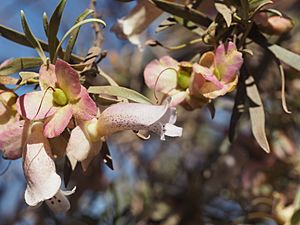Eremophila platycalyx facts for kids
Quick facts for kids Eremophila platycalyx |
|
|---|---|
 |
|
| Eremophila platycalyx subsp. platycalyx (flowers with broad sepals) | |
| Scientific classification | |
| Genus: |
Eremophila (plant)
|
| Species: |
platycalyx
|
| Synonyms | |
|
|
The Eremophila platycalyx is a type of flowering plant. It belongs to the figwort family, called Scrophulariaceae. This plant only grows in Western Australia, meaning it is endemic there.
It can be a shrub or a small tree. Its branches and leaves are covered with soft, matted hairs. Sometimes, a sticky sap called resin covers these hairs. The leaves can look different depending on the plant's type. Its sepals (the leaf-like parts that protect the flower bud) are often bright. The petals are usually cream-colored, sometimes with spots. Scientists have officially named two types of this plant, but they have found others that are still being studied.
Contents
What Does Eremophila platycalyx Look Like?
Eremophila platycalyx grows as a shrub or a small tree. It can reach a height of up to 4 meters (about 13 feet). Its branches and leaves are covered with flat, simple hairs. These hairs are often hidden by sticky resin.
Leaves and Flowers
The leaves grow one after another along the branches. They can be long and thin, or shaped like a spear or an egg. Most leaves are between 17 and 70 millimeters (0.7 to 2.8 inches) long. They are 2 to 14.5 millimeters (0.08 to 0.57 inches) wide. The leaves are covered with gray hairs that lie flat against the surface.
The flowers grow one by one where a leaf meets the stem. Each flower has a hairy stalk that is 4 to 27 millimeters (0.16 to 1.1 inches) long. There are 5 sepals that overlap. These sepals can be pink or yellow. They are usually 12 to 20 millimeters (0.47 to 0.79 inches) long.
Petals and Stamens
The petals are 15 to 40 millimeters (0.59 to 1.6 inches) long. They join together at the bottom to form a tube shape. This petal tube is cream-colored. It might have a bluish-green tint. Sometimes, it has spots on the inside or outside. The outside of the petal tube is smooth (glabrous). The petal lobes (the parts that spread out) are smooth inside and out. However, the tube itself is full of long, soft hairs. There are 4 stamens (the parts that produce pollen). They are about the same length as the petal tube.
Fruits
Eremophila platycalyx flowers from June to September. After flowering, it produces fruits. These fruits are dry and woody. They are oval-shaped and come to a point. The fruits are 5.5 to 8.5 millimeters (0.22 to 0.33 inches) long.
Naming and Types
This plant was first officially described in 1866 by Ferdinand von Mueller. He published his description in a book called Fragmenta phytographiae Australiae.
What Does the Name Mean?
The second part of the plant's name, platycalyx, comes from ancient Greek words. Platús means "flat," "broad," or "wide." Kálux means "cup" or "outer cover of a flower." This name refers to the plant's broad sepals.
Different Subspecies
There might be as many as 10 different types (subspecies) of E. platycalyx. However, only two have been officially named so far:
- Eremophila platycalyx subsp. platycalyx: This type has sepals that are egg-shaped or almost round. Its flower stalks are longer than 8.5 millimeters (0.33 inches).
- Eremophila platycalyx subsp. pardalota: This type has sepals shaped like a spear. Its flower stalks are shorter than 6.5 millimeters (0.26 inches).
Some other types have temporary names like Milgun, Neds Creek, large leaves, and small calyx. This plant is sometimes called granite eremophila. But that name is also used for another plant, E. granitica.
Where Eremophila platycalyx Grows
The platycalyx subspecies grows in rocky areas. You can find it between Leonora and Shark Bay. It grows in several regions of Western Australia, including Carnarvon, Gascoyne, Gibson Desert, Little Sandy Desert, Murchison, Pilbara, and Yalgoo.
The pardalota subspecies grows in pebbly soil. It is found between Mt Augustus and Newman. This type grows in the Gascoyne, Little Sandy Desert, and Pilbara regions.
Other types grow in specific places too. For example, the Milgun type grows on floodplains in rocky soil in the Gascoyne region. The Neds Creek type is found east of Neds Creek homestead. The large leaves type grows between Newman and Kumarina. The small calyx type is found between Paynes Find and Meekatharra.
Conservation Status
The Western Australian Government's Department of Parks and Wildlife has looked at all the known types of E. platycalyx. They have classified them as "not threatened." This means they are not currently at risk of disappearing.
Growing Eremophila platycalyx in Gardens
This eremophila plant produces many white to cream-colored flowers. These flowers attract birds that feed on nectar. Some types also have colorful sepals. These sepals stay on the plant much longer than the petals.
This plant grows slowly but lives for a long time. If you trim it lightly and regularly from a young age, it will stay compact. You can grow new plants from cuttings. You can also grow them by grafting them onto a Myoporum rootstock. It can grow in many different types of soil. It grows best in full sun. It only needs water occasionally during long dry periods. However, it can be sensitive to frost.
Images for kids




